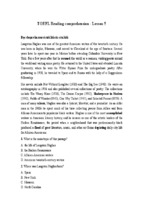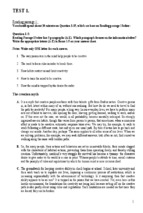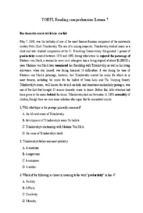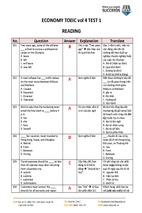LEVEL OF AUTONOMY ON THE MANAGEMENT OF
VOCATIONAL SCHOOLS IN HANOI CITY, VIETNAM
___________________________
A DISSERTATION
Presented to the Faculty of the Graduate School
Southern Luzon State University, Lucban, Quezon, Philippines
in Collaboration with
Thai Nguyen University, Socialist Republic of Vietnam
___________________________
In Partial Fulfillment
of the Requirements for the Degree
Doctor of Business Administration
___________________________
By
PHAM QUANG VINH (STONE)
December 2013
i
APPROVAL SHEET
The Dissertation of
PHAM QUANG VINH
entitled
LEVEL OF AUTONOMY ON THE MANAGEMENT OF VOCATIONAL
SCHOOLS IN HANOI CITY, VIETNAM
Submitted in Partial Fulfilment of the Requirements for the Degree
DOCTOR OF BUSINESS ADMINISTRATION
A program offered by Southern Luzon State University,
Republic of the Philippines in collaboration with
Thai Nguyen University, Socialist Republic of Vietnam
has been approved by Oral Examination Committee
WALBERTO A. MACARAAN, EdD
Expert
EDWIN P. BERNAL, DBA
Expert
MELCHOR MELO O. PLACINO, PhD
Expert
ALICE T. VALERIO, PhD
External Panel
CECILIA N. GASCON, PhD
Chairman
Endorsed by:
Recommended by:
DO ANH TAI, PhD
Adviser
APOLONIA A. ESPINOSA, PhD
Dean
Accepted in Partial Fulfilment of the Requirements for the Degree
Doctor of Business Administration
_____________________
Date
WALBERTO A. MACARAAN, EdD
Vice President for Academic Affairs
ii
CERTIFICATE OF ORIGINALITY
iii
ACKNOWLEDGMENT
In grateful recognition and sincerest thanks for the encouragement,
guidance and unselfish sharing of their knowledge, time, effort and skills, and
for the untiring motivation that leads to the completion of this study, the
researcher acknowledges the following:
DR. CECILIA N. GASCON, Ph.D., President of the Southern Luzon
State University in the Republic of the Philippines, for her untiring effort and
belief that this collaboration is possible thus enabling us to pursue the DBA
degree;
DR. DANG XUAN BINH, Ph.D., Director of the International Training
Center, Thai Nguyen University of the Socialist Republic of Vietnam, for his
enormous pursuit to provide the Vietnamese people an opportunity to grow
through education;
DR. DO ANH TAI, Ph.D., his adviser, for guidance and endless support
for the improvement of this study.
ITC STAFF, for providing the necessary research materials;
MANAGERS and STAFF of Vocational Schools in Hanoi City, my
Respondents, for their patience and cooperation in answering the
questionnaire and for other data given;
MY FAMILY and FRIENDS, for the love and support in one way or the
other and TO ALL who have contributed to make this study a success.
Phạm Quang Vinh (Stone)
iv
DEDICATION
This research is heartily dedicated
To my family and to all my relatives, my colleagues,
friends, classmates, administrators, staffs and employees
of Vocational Schools in Hanoi city.
PQV
v
TABLE OF CONTENTS
PAGE
TITLE PAGE ………………………………………………………………..
i
APPROVAL SHEET ……………………………………………………….
ii
CERTIFICATE OF ORIGINALITY ………………………………………..
iii
ACKNOWLEDGEMENT …………………………………………………..
iv
DEDICATION ………………………………………………………………
v
TABLE OF CONTENTS …………………………………………………..
vi
LIST OF TABLES ………………………………………………………….
viii
LIST OF FIGURES ………………………………………………………...
xii
ABBREVIATIONS ………………………………………………………….
xiii
LIST OF APPENDICES …………………………………………………...
xiv
ABSTRACT …………………………………………………………………
xvi
CHAPTER
I
3
Statement of the Problem ………………………………….
6
Objectives of the Study …………………………………….
7
Hypothesis of the Study ……………………………………
8
Significance of the Study …………………………………..
8
Scope and Limitations of the Study ………………………
8
Definition of Terms ………………………………………….
9
REVIEW OF LITERATURE ……………………………….
11
Conceptual Framework ………………………………….…
III
1
Background of the Study …………………………………..
II
INTRODUCTION ……………………………………………
72
METHODOLOGY
Locale of the Study …………………………………………
74
Research Design ……………………………………………
74
Determination of Sample Size …………………………….
75
Sampling Designs and Techniques ………………………
76
Subject of the Study ………………………………………..
76
vi
Research Instrument ……………………………………….
Data Gathering Procedure …………………………………
78
Statistical Treatment ………………………........…….……
79
RESULTS AND DISCUSSIONS ………………………….
80
4.1 Profile of the Respondents ……………………………
IV
77
80
4.2 Assessment of the Respondents on the Existing
Level of Autonomy on Management of Vocational
Schools in Hanoi City with Regards to Identifying
Organizational Autonomy, Financial Autonomy,
Staffing Autonomy and Academic Autonomy………..
83
4.3 Determining the Importance of Autonomy in
Vocational Schools as Perceived by the
Respondents ……………………………………………
132
4.4 Factors Affecting the Extent of Autonomy on the
Given Indicators that may be Spelled Out by Private
and Public Vocational Schools ……………………….
143
4.5 Testing a Significant Difference between the Profile
of Respondents and their Perception on the Level of
Autonomy on Management of Vocational Schools in
Hanoi City, Vietnam ……………………………………
V
145
SUMMARY OF FINDINGS, CONCLUSIONS AND
RECOMMENDATIONS
Summary of Findings ………………………………………
158
Conclusions …………………………………………………
164
Recommendations …………………………………………
166
REFERENCES ………………………...…………………………………..
171
APPENDICES ……………………………………………………………...
177
CURRICULUM VITAE …………………………………………………….
209
vii
LIST OF TABLES
TABLE
2.1
PAGE
Requirements for Implementing Autonomy, Assessment
and Accountability
30
2.2
Dimension of School Autonomy
33
2.3
Qualifications of the Executive Head
35
2.4
Restrictions on Senior Academic Staff Recruitment
44
3.1
Description of Respondents
76
3.2
Rating Scale for Respondents’ Perception on Contents in
Autonomy Actives of Vocational Schools in Hanoi City
77
Type of Data and Methods of Gathering and Processing
79
Frequency Distribution of Respondents’ Profile as
Indicated by Age, Gender, and Education
80
Frequency Distribution of Respondents’ Profile as
Indicated by the Length of Service in the Department and
Working Division
82
Mean Distribution of Responses on the Existing Level of
Autonomy on Management of Public Vocational Schools in
Hanoi City in terms of Identifying Organizational Autonomy
84
Mean Distribution of Responses on the Existing Level of
Autonomy on Management of Private Vocational Schools
in Hanoi City In Terms of Identifying Organizational
Autonomy
89
Composite of Mean Distribution of Responses on the
Existing Level of Autonomy on Management of Vocational
Schools in Hanoi City in terms of Identifying Organizational
Autonomy
93
Mean Distribution of Responses on the Existing Level of
Autonomy on Management of Public Vocational Schools in
Hanoi City in Terms of Identifying Financial Autonomy
99
Mean Distribution of Responses on the Existing Level of
Autonomy on Management of Private Vocational Schools
in Hanoi City in Terms of Identifying Financial Autonomy
102
3.3
4.1.1
4.1.2
4.2.1
4.2.2
4.2.3
4.2.4
4.2.5
viii
TABLE
4.2.6
4.2.7
4.2.8
4.2.9
4.2.10
4.2.11
4.2.12
4.3.1
4.3.2
4.3.3
4.3.4
4.3.5
PAGE
Composite of Mean Distribution of Responses on the
Existing Level of Autonomy on Management of Vocational
Schools in Hanoi City in Terms of Identifying Financial
Autonomy
107
Mean Distribution of Responses on the Existing Level of
Autonomy on Management of Public Vocational Schools in
Hanoi City in Terms of Identifying Staffing Autonomy
111
Mean Distribution of Responses on the Existing Level of
Autonomy on Management of Private Vocational Schools
in Hanoi City In Terms of Identifying Staffing Autonomy
115
Composite of Mean Distribution of Responses on the
Existing Level of Autonomy on Management of Vocational
Schools in Hanoi City in Terms of Identifying Staffing
Autonomy
118
Mean Distribution of Responses on the Existing Level of
Autonomy on Management of Public Vocational Schools in
Hanoi City in Terms of Identifying Academic Autonomy
122
Mean Distribution of Responses on the Existing Level of
Autonomy on Management of Private Vocational Schools
in Hanoi City In terms of Identifying Academic Autonomy
125
Composite of Mean Distribution of Responses on the
Existing Level of Autonomy on Management of Vocational
Schools in Hanoi City in Terms of Identifying Academic
Autonomy
129
Mean Distribution of Responses on the Importance of
Organization Autonomy Vocational schools in Hanoi city
133
Mean Distribution of Responses on the Importance of
Financial Autonomy of Vocational Schools in Hanoi City
135
Mean Distribution of Responses on the Importance of
Staffing Autonomy in Vocational Schools in Hanoi City
138
Mean Distribution of Responses on the Importance of
Academic Autonomy in Vocational Schools in Hanoi City
140
Composite of Mean Distribution of Responses on the
Importance of Autonomy Factors in Vocational Schools in
Hanoi City
142
ix
TABLE
4.4.1
4.5.1a
4.5.1b
4.5.2a
4.5.2b
4.5.3a
4.5.3b
4.5.4a
4.5.4b
4.5.5a
PAGE
Mean Distribution of Responses on the Factors should be
the Extent of Autonomy on the Given Indicators that may
be Spelled Out by Private and Public Vocational Schools in
Hanoi City
144
Significant Difference Between the Respondents’ Position and
their Perception on the Level of Autonomy on Management of
Public Vocational Schools in Hanoi City, Vietnam
145
Significant Difference Between the Respondents’ Position and
their Perception on the Level of Autonomy on Management of
Private Vocational Schools in Hanoi City, Vietnam
146
Significant Difference Between the Respondents’ Age Bracket
and their Perception on the Level of Autonomy on
Management of Public Vocational Schools in Hanoi City,
Vietnam
147
Significant Difference Between the Respondents’ Age bracket
and their Perception on the Level of Autonomy on
Management of Private Vocational Schools in Hanoi City,
Vietnam
148
Significant Difference Between the Respondents’ Education
and their Perception on the Level of Autonomy on
Management of Public Vocational Schools in Hanoi City,
Vietnam
149
Significant Difference Between the Respondents’ Education
and their Perception on the Level of Autonomy on
Management of Private Vocational Schools in Hanoi City,
Vietnam
150
Significant Difference Between the Respondents’ Gender and
their Perception on the Level of Autonomy on Management of
Public Vocational Schools in Hanoi City, Vietnam
151
Significant Difference Between the Respondents’ Gender and
their Perception on the Level of Autonomy on Management of
Private Vocational Schools in Hanoi City, Vietnam
152
Significant Difference Between the Respondents’ Experience
and their Perception on the Level of Autonomy on
Management of Public Vocational Schools in Hanoi City,
Vietnam
153
x
TABLE
4.5.5b
4.5.6a
4.5.6b
4.5.7
PAGE
Significant Difference Between the Respondents’ Experience
and their Perception on the Level of Autonomy on
Management of Private Vocational Schools in Hanoi City,
Vietnam
154
Significant Difference between the Respondents’ Working
Division and their Perception on the Level of Autonomy on
Management of Public Vocational Schools in Hanoi City,
Vietnam
155
Significant Difference Between the Respondents’ Working
Division and their Perception on the Level of Autonomy on
Management of Private Vocational Schools in Hanoi City,
Vietnam
156
Significant Difference Between the Public and Private
School’s Evaluation on the Level of Autonomy on
Management of Vocational Schools in Hanoi City, Vietnam
157
xi
LIST OF FIGURES
FIGURE
PAGE
1
Ability to Keep a Surplus
39
2
Ability to Sell School-Owned Real Estate
42
3
Overall Student Numbers
49
4
The Education System in Vietnam
53
5
Research Model for Assessment of the Level of Autonomy
on the Management of Vocational Schools in Hanoi,
Vietnam
73
xii
ABBREVIATIONS
AT
Austria
BE fr
Belgium/French Community
BE nl
Belgium/Flemish Community
BG
Bulgaria
BPNT
Basic Psychological Needs Theory
CET
Cognitive Evaluation Theory
CH
Switzerland
COT
Causality Orientations Theory
CY
Cyprus
CZ
Czech Republic
DE
Germany
DK
Denmark
EE
Estonia
ES
Spain
FI
Finland
FR
France
GCT
Goal Contents Theory
GDV
General Department of Vocational
GR
Greece
HNETO
Hanoi Education and Training Office
HR
Croatia
HRM
Human Recourse Management
HU
Hungary
IS
Iceland
IT
Italy
LT
Lithuania
LU
Luxembourg
LV
Latvia
MOET
Ministry of Education and Training
MOLISA
Ministry of Labour - Invalids - Social Affairs
MT
Malta
xiii
NL
Netherlands
NO
Norway
OEI
Occupational Education Institution
OIT
Organism Integration Theory
PIED
Professional Intermediate Education Department
PIS
Professional Intermediate School
PL
Poland
PT
Portugal
RO
Romania
RS
Serbia
SDT
Self-Determination Theory
SE
Sweden
SI
Slovenia
SK
Slovak Republic
TR
Turkey
UK
United Kingdom
VC
Vocational College
VS
Vocational School
xiv
LIST OF APPENDICES
APPENDIX
PAGE
A
Questionnaire Checklist
178
B
Raw Data
194
C
Anova Tables
195
`
xv
ABSTRACT
Title of Research
: LEVEL OF AUTONOMY ON THE
MANAGEMENT OF VOCATIONAL SCHOOLS
IN HANOI CITY, VIETNAM
Researcher
: PHAM QUANG VINH (STONE)
Degree Conferred
: DOCTOR OF BUSINESS ADMINISTRATION
Name and Address
of Institution
: Southern Luzon State University, Lucban, Quezon,
Philippines and Thai Nguyen University, Socialist
Republic of Vietnam
Adviser
: Dr. Do Anh Tai
Year Written
: 2013
______________________________________________________________
This
dissertation
with
the
title
"Level
of Autonomy
on the
Management of Vocational Schools in Hanoi City, Vietnam ", has for its
objective the evaluation of the actual operation of autonomous vocational
schools in Hanoi, as well as the review of literature about the autonomy of
schools in general and of vocational schools in particular. This study reviews
the operational status of autonomy in vocational schools in Hanoi based on
certain criteria to determine the actual circumstances obtaining in these
institutions and the key element for autonomy in vocational schools in Hanoi.
This study uses the method of descriptive statistics, comparison
statistics and analysis of variance through the selection of two types of
vocational schools in Hanoi, both public and private.
Two groups of
respondents are chosen in each type of school to measure their perceptions
about managing the operational autonomy in schools.
Research has shown the operational autonomy of vocational schools in
Hanoi at the outset. The concept, content and the policy on school autonomy
xvi
has not been publicized. Hypothesis test results also show that there is not
much difference in the perception of the respondent group about the status of
content management autonomy in vocational schools in Hanoi. The study
likewise shows that there is no difference in terms of autonomy between the
two types of vocational schools. Private schools have a higher degree of
autonomy than public schools. However the operation of autonomous school
in Vietnam is strictly controlled by the government.
The main research results show that school autonomy in Vietnam has
not been taken seriously. There is actually an unfair treatment in the
government's implementation policy in favor of private schools with respect to
infrastructure and training programs. Therefore, the government needs to be
aware of the school’s right to self-determination specifically in matters
pertinent to organization, finances, human resources and academics. The
government should not discriminate the type of school in the implementation
of its educational policy and grant of autonomy.
xvii
1
Chapter I
INTRODUCTION
Autonomy is a topic of great interest, which is often mentioned in the
forums of education - training in Vietnam. It is the primary concern of the
school as well as the state management agencies in the midst of varying
opinions and conflicting viewpoints. Although the general direction is bold
autonomy and self-responsibility of the schools to increase their flexibility,
many specific issues that are given out to discuss such as licensing and how
to license, the mechanism of state control to let off without relinquishing
management while enhancing the effective operation of the school, etc. have
of late become a matter of primary concern.
Autonomy of institutions in the field of education is understood as selfdetermination and self-responsibility under the laws and the requirements of
society for all its activities such as finance, personnel and organizational
structure, training programs, strategic planning, etc.
Under the provisions of Vietnam laws, the level of autonomy of the
education and training institutions (collectively, the schools) depends on the
type of school. Currently in Vietnam, the system of Occupational Education
includes the professional intermediate schools, vocational schools, vocational
colleges, and some colleges and universities, which have Vocational
Education models (after here, referred to as Vocational School) under two
different types (Nguyen Duc Toan, 2010):
-
Private Schools: all of them are full autonomy.
2
-
Public Schools: three kinds that are non-autonomy, partial
autonomy, and full autonomy.
Each type of school is influenced by the different legal documents and
regulations regarding its autonomy.
Autonomy does not mean relinquishing management from the state. In
contrast, autonomy given to schools is considered as one of the most
important solutions to motivate and bring a new life into these training
institutions to improve their efficiency, educational quality and social
responsibility.
Vietnam is in the process of institutional transformation from the
planning - bureaucracy - subsidy economy to complete market economy.
Accordingly, education and training is not only seen as a public utility sector,
but also considered an important service sector that has been contributing
significantly to the sustainable development of market economy. Ensuring
autonomy for training institutions is a prerequisite for these institutions to
adjust their activities in accordance with market mechanism, which requires
the dynamic, creation, activeness and accepts the changes frequently.
The scope of this study will try to approach a relative full autonomy of
the occupational educational institutions and its impact on the activities of
these schools. This study will also try to compare the existing legal provisions
with some experiences of developed countries to put forward some
recommendations to improve and enhance the effectiveness of the policy
framework for Occupational Education field as well as the advancement of
each school.
3
Background of the Study
The developments towards a different model of governance in many
advanced societies have been characterized with the phrase “regulatory
state” (Moran 2002), i.e. a state where direct public ownership is replaced by
regulating more autonomous units. Higher education is subject to similar
changes and is waiting for a systematic analysis from a regulatory approach
(King 2007). As a general rule, vocational schools have become more
autonomous – free from line-itemized budgets, input control, and detailed
prescriptions on curricula (Santiago et al. 2008). The greater autonomy is at
the same time balanced by new accountability mechanisms (Santiago et al.
2008). Therefore, the autonomy of the schools is limited to make the selection
of the training majors as well as to determine the suitable training model upon
requests of the labour markets and training capacities of schools actively.
According to Circular No115/2010/ND-CP dated 24/12/2010 of the
Government, this responsibility has been transferred to the local Education &
Training departments. However, these departments are continuously
encountering difficulties in dealing with this new task leading to the delays,
lack of the uniformity in approving the procedures to open new majors and
giving the annual recruitment quantity, GOV (2010).
At present, Vietnam does not have sufficient legislation to encourage
the enterprises and schools in launching a national ,cooperative effort for
students to meet the demands of the labour market. Schools still train
students with their own programs without being concerned much about what
the labour market requires. The stagnation and the inactivity of the schools
- Xem thêm -





















